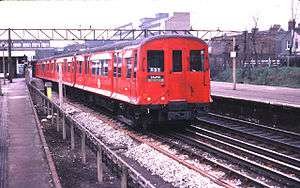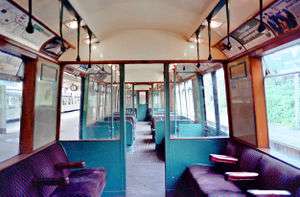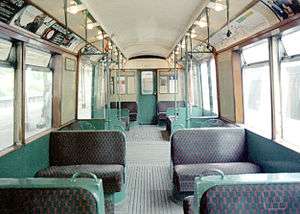London Underground O and P Stock
| O Stock, P Stock, CO/CP Stock | |
|---|---|
 | |
| In service | 1937–1981 |
| Manufacturer |
GRC&W BRC&W |
| Specifications | |
| Car length | 51 ft (15.54 m) |
| Width | 9 ft 8 3⁄8 in (2.956 m) |
| Height | 11 ft 9 1⁄2 in (3.594 m) |
| Weight | 35.75 long tons (36.32 t; 40.04 short tons) |
| Seating | 42 |
| Stock type | Subsurface |
| Notes | |
|
| |
The London Underground O and P Stock electric multiple units were used on the London Underground from 1937 to 1981. O Stock trains were built for the Hammersmith & City line, using metadyne control equipment with regenerative braking, but the trains were made up entirely of motor cars and this caused technical problems with the traction supply so trailer cars were added. P Stock cars were built to run together with the O Stock cars now surplus on Metropolitan line Uxbridge services. The trains had air-operated sliding doors under control of the guard; the O Stock with controls in the cab whereas the P Stock controls in the trailing end of the motor cars. The P Stock was introduced with first class accommodation, but this was withdrawn in 1940.
In the early 1950s some Uxbridge O and P Stock trains were transferred to the Circle line. The increasingly unreliable metadynes were replaced and the converted trains became known as CO/CP stock. In the early 1960s the remaining Uxbridge CO/CP Stock trains were transferred to the District line, so that during the 1960s generally Hammersmith & City and Circle line services were operated by CO stock and CP stock was used on the District line. Following the introduction of C69 Stock in the early 1970s all CO and CP Stock trains were used on the District line until they were replaced by the C Stock and D Stock trains; the last train running in service in 1981.
Construction
In 1934 an experimental six-car train was built using a multiple-unit train control system developed by Metropolitan Vickers. The metadyne equipment controlled four traction motors on two cars and allowed for regenerative braking, although an air braking was fitted for low speeds and if the traction supply was unreceptive to the regenerated current.[1]
As part of the 1935–40 New Works Programme the O stock, sets of two motor cars, was built for the Hammersmith & City line. The Gloucester Railway Carriage and Wagon Company (GRC&W) and the Birmingham Railway Carriage & Wagon Company (BRC&W) built 116 cars, allowing 19 six-car trains and a spare two-car set. The new trains entered service as a four-car train between High Street Kensington and Putney Bridge on 13 September 1937 and a full length six car train later entering service on 10 December on the Hammersmith & City line.[1] The guard's position was in the cab, continuing the practice of the Metropolitan Railway.[2] Technical problems were found with the traction supply with trains made up entirely of motor cars and 58 trailer cars were ordered from Gloucester and the trains reformed into three car sets. The first reformed train went into service on 18 July 1938,[3] and 19 O Stock sets were transferred to the Metropolitan line.[4]
With O Stock cars available, 73 sets of P stock were ordered for the Metropolitan line. Six and eight car trains were needed, so six car trains were made up from two three car units formed of two driving motor cars and a trailer and eight cars by adding a two car unit.[4] The guard's position on the P Stock was at the inner ends of the motor cars,[5] as the cabs on eight car trains could still be in tunnel at stations with short platforms. The O Stock units, with the guard position in the cab, were split up and motor cars placed in the centre of the six car trains so that the door controls in these cabs were not needed. Six P1 motor cars were built without door controls and ran in the same position.[4][6] Although a train could be made up from O and P Stock cars, and the units had automatic couplers on the outer ends of the motor cars, the metadynes were not interchangeable.[4] The first P Stock train entered service on 17 July 1939.[5] Six-car O Stock trains operated on the Hammersmith & City service, and the mixed O and P Stock trains provided the services to Uxbridge.[4]
Description
The 51-foot (16 m) long O Stock cars were fitted with air operated doors under the control of the guard. A car had 40 seats and two tip up and access was by two double doors and a single door on each side. Externally, the cars had side panels that flared at the bottom with no running boards to prevent passengers jumping on a moving train and attempting to open a door.[9] The trailers, with four extra seats,[3] had a hinged door at one end, locked closed in normal use, so they could be converted into driving motor cars.[5] Lighting was provided by incandescent bulbs in the roof.[3]
War time losses
During World War II several cars were lost. 14199 (O stock DM) was destroyed at Neasden on 27 September 1940, 13036, 14042, 14049 (all O stock DM), 13229, 14229 (all P Stock DM), 014080 (O stock trailer) at Moorgate station on 29 December 1941, and 14263 (P stock DM) at Baker Street on 10 May 1941. To make up for the number of 'D' end DMs (14xxx) cars destroyed, three 'D' end trailer cars were rebuilt into DMs. These were 014270-014272 which were renumbered 14270-14272 when converted.[10] DM 14233 was damaged during bombing and one end of the car was destroyed. This was repaired using an end of Q38 Stock trailer 013167, which had also been badly damaged.[4] The rebuilt car entered service renumbered 14233 in 1941; it became 54233 in 1963.[11]
Reconstruction into CO/CP Stock
In the early 1950s F Stock was transferred to the Metropolitan line Uxbridge service, and some O and P Stock, reformed into 5-car trains transferred to replace the trains on the Circle line; these began running in 1947.[4][12] Because of the reliability of the metadynes and the difficulty repairing them, one Circle line train was converted to use the pneumatic camshaft control (PCM) equipment used on the 1938 tube stock and entered service in March 1955. This was considered a success and the other Circle line trains were converted, followed by the units that operated the Hammersmith & City services.[4] The converted trains were known as CO/CP stock, converted motor cars became CO or CP stock and the trailers COP stock.[4] In 1959/60 the length of the Circle line trains was increased to six cars with the addition of converted Q38 trailers, and with similar trains running on the Hammersmith & City and Circle lines maintenance for the stock for the two lines was concentrated at Hammersmith depot, allowing Neasden depot to specialise in the new A Stock.[13]
In the early 1960s the remaining O and P Stock trains that operated the Uxbridge service, still with their metadyne controls, were converted and transferred to the District line as the second batch of A Stock was introduced. In the 1960s the Hammersmith & City and Circle line services were generally operated by CO stock and CP stock used on the District line.[14] In the early 1970s the introduction of the C69 Stock allowed the CO Stock to be transferred to the District line and instead of running 6-car trains off-peak and 8-cars during peak hours, trains were reformed into standard 7-car trains.[13]
Withdrawal and preservation
The introduction of C77 stock on the Edgware Road services allowed CO/CP Stock cars to be scrapped, and from January 1980 the remainder was replaced by new D78 stock. The last trains ran in service in 1981, when two six-car trains operated special workings.[13]
One complete unit DM 53028, T 013063 and DM 54233 have been preserved at the Buckinghamshire Railway Centre.[15] The driving motor 54233 was the one that was rebuilt using one end of a Q38 trailer in 1941.[16] A DM 54256 was also preserved at the Walthamstow Pump House Museum[17] but has since moved to Whitwell & Reepham railway station as part of their collection. Vehicles 53028 and 013063 are CO Stock and 54233 and 54256 are CP Stock.
Numbering
As built the numbers were as follows:
| 'O' Stock | ||
|---|---|---|
| 'A' DM | 'D' DM | T |
| 13000 - 13057 | 14000 - 14057 | 013058 - 013086 014058 - 014086 |
| 'P' Stock | ||
|---|---|---|
| 'A' DM | 'D' DM | T |
| 13193 - 13257 13262 - 13269* |
14193 - 14257 14262 - 14269 |
013087 - 013101 013258 - 013273 014087 - 014100 014258 - 014273 |
Cars 13264 - 13269 were designated P1 stock.
References
Notes
- 1 2 Bruce 1983, p. 90.
- ↑ Bruce 1983, p. 91.
- 1 2 3 Bruce 1983, p. 93.
- 1 2 3 4 5 6 7 8 9 Bruce 1983, p. 94.
- 1 2 3 Bruce 1983, p. 92.
- ↑ Horne 2003, p. 64.
- ↑ Horne 2003, p. 65.
- ↑ Horne 2003, p. 66.
- ↑ Bruce 1983, pp. 90–91.
- ↑ Connor 1981, pp. 11, 47, 51.
- ↑ Connor 1981, pp. 9, 46, 53.
- ↑ Horne 2003, p. 80.
- 1 2 3 Bruce 1983, p. 95.
- ↑ Bruce 1983, pp. 94–95.
- ↑ Sources: brc-stockbook.co.uk. Retrieved 10 February 2013.
DM 53028 T 013063 DM 54233 - ↑ "DM 54233". brc-stockbook.co.uk. Retrieved 10 February 2013.
- ↑ Hardy 2002, p. 72.
References
- Bruce, J Graeme (1983). Steam to Silver: A History of London Transport Surface Rolling Stock. Capital Transport. ISBN 978-0-904711-45-5.
- Connor, Piers (1981). The 'COP' Stock Story. Ealing: London Underground Railway Society.
- Hardy, Brian (2002). London Underground Rolling Stock (15th Edition). Capital Transport. ISBN 978-1-85414-263-4.
- Horne, Mike (2003). The Metropolitan Line. Capital Transport. ISBN 1-85414-275-5.
Further reading
- Huntley, Ian (1988). Surface Stock Planbook 1863–1959. The London Underground. Shepperton: Ian Allan. ISBN 0-7110-1721-2.
- Hardy, Brian (2002). Surface Stock 1933–1959. Underground Train File. Harrow Weald: Capital Transport. ISBN 1-85414-247-X.
External links
| Wikimedia Commons has media related to London Underground O and P Stock. |

